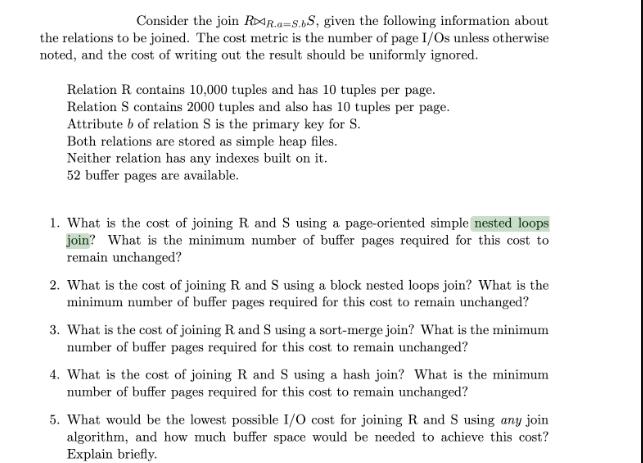Answered step by step
Verified Expert Solution
Question
1 Approved Answer
Consider the join RR.-S.S, given the following information about the relations to be joined. The cost metric is the number of page I/Os unless

Consider the join RR.-S.S, given the following information about the relations to be joined. The cost metric is the number of page I/Os unless otherwise noted, and the cost of writing out the result should be uniformly ignored. Relation R contains 10,000 tuples and has 10 tuples per page. Relation S contains 2000 tuples and also has 10 tuples per page. Attribute b of relation S is the primary key for S. Both relations are stored as simple heap files. Neither relation has any indexes built on it. 52 buffer pages are available. 1. What is the cost of joining R. and S using a page-oriented simple nested loops join? What is the minimum number of buffer pages required for this cost to remain unchanged? 2. What is the cost of joining R and S using a block nested loops join? What is the minimum number of buffer pages required for this cost to remain unchanged? 3. What is the cost of joining R and S using a sort-merge join? What is the minimum number of buffer pages required for this cost to remain unchanged? 4. What is the cost of joining R and S using a hash join? What is the minimum number of buffer pages required for this cost to remain unchanged? 5. What would be the lowest possible I/O cost for joining R and S using any join algorithm, and how much buffer space would be needed to achieve this cost? Explain briefly.
Step by Step Solution
There are 3 Steps involved in it
Step: 1
To answer these questions well evaluate each join algorithm based on the provided information about the relations R and S Given Information R 10000 tu...
Get Instant Access to Expert-Tailored Solutions
See step-by-step solutions with expert insights and AI powered tools for academic success
Step: 2

Step: 3

Ace Your Homework with AI
Get the answers you need in no time with our AI-driven, step-by-step assistance
Get Started


